Bronze Rotary Gear standard pump housings and helical gears are made of top quality bronze. Shafts are stainless steel. Pumps are available with bronze bearings and grease fittings or with carbon bearings which require no lubrication. Dynamic seal arrangements include packing, lip, or mechanical seals for a variety of application requirements. Static cover o-ring seals eliminate gasket problems
- Bronze Corrosion Resistant Castings
- Special Cast Bronze Gears
- Stainless Steel Shafts & Fasteners
- Heavy Duty Carbon Bearings (Self Lubricating)
- Positive Displacement Flow
Bronze Rotary Gear pumps are of the external gear positive displacement type, displacing a finite volume of fluid with each shaft revolution. As such, capacity varies in direct proportion to pump speed. They are suited to handle clear lubricating and non-lubricating fluids, with PH ranging from 4 to 11, and temperatures to 400F. These pumps handle viscous fluids to 100,000 cps (462000 SSU) at reduced shaft speeds, with flow rates to 175 GPM (662 LPM), differential pressures to 150 psig (10.3 BAR), and suction lift capability to 20 feet (6.1 meters) for new pumps.
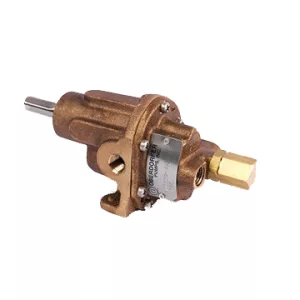
Bronze Gear Pump – N1000
Pump housings and gears are made of top quality bronze, shafts are 303 stainless steel. Bearings are made of high performance carbon-graphite material selected for wear resistance and long service life. Gear pumps are positive displacement pumps. Each shaft revolution displaces a definite amount of liquid relatively unaffected by the backpressure in the discharge line. Shaft speed and flow are directly proportional.
Features
- Bronze Corrosion Resistant Castings
- Special Cast Bronze Gears
- Stainless Steel Shafts & Fasteners
- Formed Ring Seal Packing (Lip & Mechanical Seals on Special Order)
- Heavy Duty Carbon Bearings (Self Lubricating)
- Positive Displacement Flow
Performance
- Max Flow: 21 GPM – 7.95 LPM
- Max Pressure: 150 PSI – 10 BAR
Drive
Either direct drive with flexible coupling or pulley drive can be used. Make sure both flexible coupling halves are properly aligned. When using a pulley, do not overtighten the belt. Also, to absorb belt side thrust at higher pressures and larger size pumps, an external ball bearing support is recommended – consult factory.
LIQUIDS & TEMPERATURES
Service life will be increased substantially if the liquid pumped is clean and has some degree of lubricity. These positive displacement pumps have tight tolerances. Fine abrasives like sand, silt, or powders in suspension will accelerate pump wear and reduce throughput.
Liquids compatible with bronze and stainless steel can be pumped providing proper seal has been specified (see chemical compatibility or check factory). When possible, flush the pump after each usage.
Temperature extremes are detrimental to service life and should be avoided. Basic metals of construction allow a temperature range of -40°F to 400°F. Some lip and mechanical seal elastomers have a limit of 212°F. (see engineering data or check factory). Allowing a liquid to freeze in the pump can cause damage.
SUCTION LIFT
Close tolerances and the positive pumping action make the rotary gear pump capable of lifting water on the suction side as high as 20 feet. Though gear pumps are self priming, a foot valve is recommended. If possible, wet the gears with liquid to be pumped for the first dry start. Liquid retained in the system and gear chambers serves to “wet” the pump on subsequent starts.
PERFORMANCE
Close tolerances and the positive pumping action make the rotary gear pump capable of lifting water on the suction side as high as 20 feet. Though gear pumps are self priming, a foot valve is recommended. If possible, wet the gears with liquid to be pumped for the first dry start. Liquid retained in the system and gear chambers serves to “wet” the pump on subsequent starts.
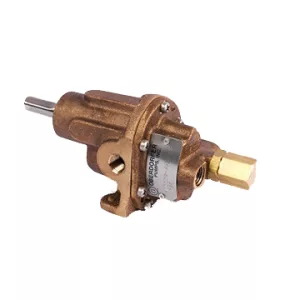
Bronze Gear Pump – N2000
Pump housings and gears are made of top quality bronze, shafts are 303 stainless steel. Bearings are made of high performance carbon-graphite material selected for wear resistance and long service life. Gear pumps are positive displacement pumps. Each shaft revolution displaces a definite amount of liquid relatively unaffected by the backpressure in the discharge line. Shaft speed and flow are directly proportional.
Features
- Bronze Corrosion Resistant Castings
- Special Cast Bronze Gears
- Stainless Steel Shafts & Fasteners
- Formed Ring Seal Packing (Lip & Mechanical Seals on Special Order)
- Heavy Duty Carbon Bearings (Self Lubricating)
- Positive Displacement Flow
Performance
- Max Flow: 4.2 GPM – 15.90 LPM
- Max Pressure: 150 PSI – 10 BAR
DRIVE
Either direct drive with flexible coupling or pulley drive can be used. Make sure both flexible coupling halves are properly aligned. When using a pulley, do not over tighten the belt. Also, to absorb belt side thrust at higher pressures and larger size pumps, an external ball bearing support is recommended – consult factory.
LIQUIDS & TEMPERATURES
Service life will be increased substantially if the liquid pumped is clean and has some degree of lubricity. These positive displacement pumps have tight tolerances. Fine abrasives like sand, silt, or powders in suspension will accelerate pump wear and reduce throughput. Liquids compatible with bronze and stainless steel can be pumped providing proper seal has been specified (see chemical compatibility or check factory). When possible, flush the pump after each usage. Temperature extremes are detrimental to service life and should be avoided. Basic metals of construction allow a temperature range of -40°F to 400°F. Some lip and mechanical seal elastomers have a limit of 212°F. (see engineering data or check factory). Allowing a liquid to freeze in the pump can cause damage.
SUCTION LIFT
Close tolerances and the positive pumping action make the rotary gear pump capable of lifting water on the suction side as high as 20 feet. Though gear pumps are self priming, a foot valve is recommended. If possible, wet the gears with liquid to be pumped for the first dry start. Liquid retained in the system and gear chambers serves to “wet” the pump on subsequent starts.
*For pressures over 100 psi, the above selections are suitable for pumping fluids with lubricity (e.q. oils, polymers). Service life will decrease for fluids without lubricity (e.q. water, solvents).
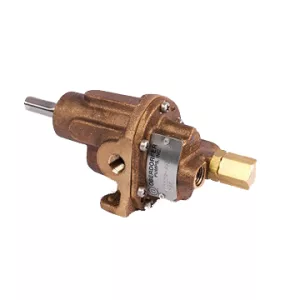
Bronze Gear Pump – N3000
Pump housings and gears are made of top quality bronze, shafts are 303 stainless steel. Bearings are made of high performance carbon-graphite material selected for wear resistance and long service life. Gear pumps are positive displacement pumps. Each shaft revolution displaces a definite amount of liquid relatively unaffected by the back pressure in the discharge line. Shaft speed and flow are directly proportional.
Features
- Bronze Corrosion Resistant Castings
- Special Cast Bronze Gears
- Stainless Steel Shafts & Fasteners
- Formed Ring Seal Packing (Lip & Mechanical Seals on Special Order)
- Heavy Duty Carbon Bearings (Self Lubricating)
- Positive Displacement Flow
Performance
- Max Flow: 7.25 GPM – 27.44 LPM
- Max Pressure: 150 PSI – 10 BAR
DRIVE
Either direct drive with flexible coupling or pulley drive can be used. Make sure both flexible coupling halves are properly aligned. When using a pulley, do not over tighten the belt. Also, to absorb belt side thrust at higher pressures and larger size pumps, an external ball bearing support is recommended -consult factory.
LIQUIDS & TEMPERATURES
Service life will be increased substantially if the liquid pumped is clean and has some degree of lubricity. These positive displacement pumps have tight tolerances. Fine abrasives like sand, silt, or powders in suspension will accelerate pump wear and reduce throughput. Liquids compatible with bronze and stainless steel can be pumped providing proper seal has been specified (see chemical compatibility or check factory). When possible, flush the pump after each usage. Temperature extremes are detrimental to service life and should be avoided. Basic metals of construction allow a temperature range of -40°F to 400°F. Some lip and mechanical seal elastomers have a limit of 212°F. (see engineering data or check factory). Allowing a liquid to freeze in the pump can cause damage.
SUCTION LIFT
Close tolerances and the positive pumping action make the rotary gear pump capable of lifting water on the suction side as high as 20 feet. Though gear pumps are self priming, a foot valve is recommended. If possible, wet the gears with liquid to be pumped for the first dry start. Liquid retained in the system and gear chambers serves to “wet” the pump on subsequent starts.
BY-PASS AND ROTATION
The pump by-pass is not intended to be a metering or flow control device. Its main purpose is to function as a pressure relief when the desired set point is exceeded, overheating can occur within 5 -10 minutes if the discharge line is completely shut off for extended periods. Reversing rotation reverses the “IN” and “OUT” ports and the location of the by-pass ports have to be reversed.
The by-pass valve is factory set at 50 p.s.i. To increase the set point, turn the by-pass valve adjusting screw in a clockwise direction.
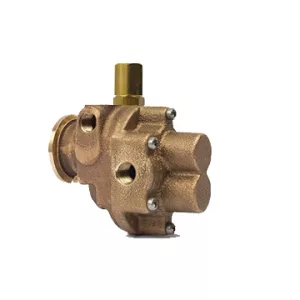
Bronze Gear Pump – N91
The carbonator motor mounting uses a circular clamp, similar to a hose clamp, as means of attaching the pump to a specially machined hub on the motor. This concept was first developed for the vending machine industry to pump carbonated beverages in soft drink dispensers. The main advantages are compactness and economy due to the elimination of the adapter casting. Carbonator motors are readily available from electric motor distributors.
Features
- Bronze Body, Stainless Steel Shaft
- Nitrile Mechanical Seal (fluoroelastomer optional)
- Self-lubricating Carbon Bearings
- Carbonator Motor Mount
- Bronze Spur Gears
- 200 PSI capability
- Superior to Vane Pumps
Performance
- Max Flow: 2.1 GPM – 7.95 LPM
- Max Pressure: 300 PSI – 20 BAR
LIQUIDS & TEMPERATURES
Bronze pumps are suitable for water, oil, and mild chemicals in the pH-range from 4-10. Viscous liquids may be handled with carbonator pumps up to a viscosity of 300 SSU. Higher viscosities require a pump speed lower than 1725 RPM, which is currently not available in carbonator motors. Liquids containing abrasives, solids, powders or pigments are highly detrimental to pump life and must be avoided. The recommended liquid temperature range is from 32°F to 140°F. If more extreme temperature conditions exist, factory should be consulted. Allowing the liquid to freeze in the pump can cause damage.
SUCTION LIFT
For a first start-up, the pump should be primed to avoid dry running. Gear pumps are self-priming, but a foot valve with strainer is recommended at the beginning of the suction line. This will keep the gear chamber primed to insure instant flow when the pump is started. Maximum suction lift is 20 feet. The suction line should be as short as possible.
ROTATION AND RELIEF VALVE
The relief valve is not intended to be a metering or flow control device. Its main purpose is to function as a discharge pressure relief when the discharge pressure exceeds the spring tension. Overheating can occur within 5-10 minutes if the discharge line is completely shut off for extended periods.
Unless otherwise specified, the pump motor unit is supplied by the factory for shaft rotation clockwise from shaft end. Reversing the motor rotation will reverse the “in” and “out” ports and also requires changing the relief valve location. The relief valve is always on the discharge side in this pump series. The factory pressure setting is 50 PSIG. To increase pressure, turn the relief valve adjusting screw in a clockwise direction. For relief settings between 100-200 PSI, specify high-pressure spring (N91D)
To reverse single-phase motors, find instructions on the inside of the junction box cover or on the nameplate of the motor.
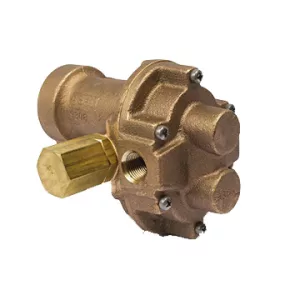
Bronze Gear Pump – N991
Pump housings and gears are made of top quality bronze, shafts are 303 stainless steel. Bearings are designed of high performance carbon-graphite material selected for wear resistance and long service life.
Gear pumps are positive displacement pumps. Each shaft revolution displaces a definite amount of liquid relatively unaffected by the backpressure in the discharge line. Shaft speed and flow are directly proportional.
Recommended pressure limits are 100 PSI for water and non-lubricants, 150 PSI for oil and other lubricants. The maximum shaft speed is 1750 RPM. Close-coupled gear pumps are normally supplied with a Nitrile lip seal. A lip seal made of fluoroelastomer is available as an option. For a fluoroelastomer Seal, add S5 to the pump model number.
Features
- Rugged corrosion resistant bronze construction
- Compact close-coupled design
- Stainless steel shafts
- Durable bronze spur gears
- Process lubricated carbon graphite bearings
- O-ring cover seal for maximum leak protection
- Nitrile Lip Seal -standard
- Easy field assembly to a variety of motor frames
- For typical DC motor pump units – see N991-32 DC
- For compact AC motor pump units – see Close Coupled Bronze Adapterless Rotary Gear Pumps
- For bronze pedestal pumps and mechanical seal styles – see model N1000
Performance
- Max Flow: 2.1 GPM – 7.95 LPM
- Max Pressure: 150 PSI – 10 BAR
DRIVE
Close-coupled pumps are mounted directly to the electric motor by means of a suitable adapter bracket. The pump drive shaft is connected to the motor shaft by a flexible coupling.
LIQUIDS & TEMPERATURES
These pumps are suitable for all liquids that are compatible with bronze. Most common liquids are water, oil, and mild chemicals in the pH range of 4 to 11. Viscous liquids require reduced shaft speeds of 1150 RPM or lower. (Consult factory.) Liquids containing solids, abrasives, powders, or paint pigments are definitely not recommended for gear pumps. If abrasives are unavoidable, use a very low shaft speed. The recommended liquid temperature range is from 32°F to 140°F for best pump life. If more extreme temperature conditions exist, factory should be consulted. Freezing of water-filled pumps can cause damage and must be avoided. Oils at low temperatures are very viscous requiring a lower speed or extra power.
SUCTION LIFT
As a general rule, the suction lift should be kept at an absolute minimum by placing the pump as close to the liquid source as possible. A gear pump in new condition can lift 20 feet of water in the suction line. A foot valve (preferably with built-in strainer) is recommended at the beginning of the suction line. For a first start-up, the pump should be primed to avoid dry running. Minimum size of the suction pipe is the size of the pump inlet port. For longer suction lines (over 3 feet) or for viscous liquids, the pipe should be at least one size or two sizes larger than the pump inlet port.
ROTATION AND RELIEF VALVE
If the discharge line contains any throttling devices such as a shut-off valve, a spray nozzle or other restrictive device, it is necessary to have a relief valve in the system which returns the liquid to the suction side or to the tank. The relief valve is also available as part of the pump itself (R-model pumps). However, built-in relief valves are only good for intermittent service. If used continuously, the pump will overheat. A built-in relief valve is strictly a safety device against overpressure. It will not work successfully as a pressure or flow control device. For this purpose a separate relief valve in the pressure line must be used. Unless otherwise specified, the pump motor unit is supplied by the factory for shaft rotation counterclockwise from shaft end. Reversing motor will reverse “in and “out” ports and also requires changing relief valve location. The relief valve is always on the inlet side of this pump series. The factory pressure setting is 50 PSIG. To increase pressure, turn the relief valve adjusting screw in a clockwise direction.
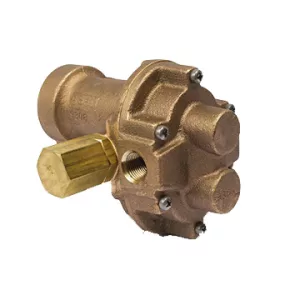
Bronze Gear Pump – N992
Pump housings and gears are made of top quality bronze, shafts are 303 stainless steel. Bearings are designed of high performance carbon-graphite material selected for wear resistance and long service life.
Gear pumps are positive displacement pumps. Each shaft revolution displaces a definite amount of liquid relatively unaffected by the back pressure in the discharge line. Shaft speed and flow are directly proportional.
Recommended pressure limits are 100 PSI for water and non-lubricants, 150 PSI for oil and other lubricants. The maximum shaft speed is 1750 RPM.
Features
- Rugged Corrosion Resistant Bronze Construction
- Compact Close-Coupled Design
- Stainless Steel Shafts
- Durable Bronze Helical Gears Provide Quiet Operation
- Process Lubricated Carbon Graphite Bearings
- O-Ring Cover Seal For Maximum Leak Protection
- Lip Seal or Mechanical Seal
Easy Field Assembly to a Variety of Motor Frames – For Typical DC Motor Pump Units – see N992 DC
– For Compact AC Motor Pump Units see Close Coupled Bronze Adapterless Rotary Gear Pumps – For Danfoss Hydraulic Motor Driven Pump Units – See Adapter 9960 For Bonze Pedestal Pumps – See Model N2000 For Close-Coupled Ductile Iron Pumps – See Model C992
Performance
- Max Flow: 4.07 GPM – 15.4 LPM
- Max Pressure: 150 PSI – 10 BAR
LIQUIDS & TEMPERATURES
These pumps are suitable for all liquids that are compatible with bronze. Most common liquids are water, oil, and mild chemicals in the pH range of 4 to 11. Viscous liquids require reduced shaft speeds of 1150 RPM or lower. (Consult factory.) Liquids containing solids, abrasives, powders, or paint pigments are definitely not recommended for gear pumps. If abrasives are unavoidable, use a very low shaft speed. See price book for the recommended liquid temperature range of lip and mechanical seals. If more extreme temperature conditions exist, factory should be consulted. Freezing of water-filled pumps can cause damage and must be avoided. Oils at low temperatures are very viscous requiring a lower speed or extra power.
SUCTION LIFT
As a general rule, the suction lift should be kept at an absolute minimum by placing the pump as close to the liquid source as possible. A gear pump in new condition can lift 20 feet of water in the suction line. A foot valve (preferably with built-in strainer) is recommended at the beginning of the suction line. For a first startup, the pump should be primed to avoid dry running. Minimum size of the suction pipe is the size of the pump inlet port. For longer suction lines (over 3 feet) or for viscous liquids, the pipe should be at least one size or two sizes larger than the pump inlet port. If the discharge line contains any throttling devices such as a shut-off valve, a spray nozzle or other restrictive device, it is necessary to have a relief valve in the system, which returns the liquid to the suction side or to the tank. The relief valve is also available as part of the pump itself (R-model pumps). However, built-in relief valves are only good for intermittent service. If used continuously, the pump will overheat. A built-in relief valve is strictly a safety device against overpressure. It will not work successfully as a pressure or flow control device. For this purpose a separate relief valve in the pressure line must be used. Unless otherwise specified, the pump motor unit is supplied by the factory for shaft rotation counterclockwise from shaft end. Reversing motor will reverse “in and “out” ports and also requires changing relief valve location. The relief valve is always on the inlet side of this pump series. The factory pressure setting is 50 PSIG. To increase pressure, turn the relief valve adjusting screw in a clockwise direction.
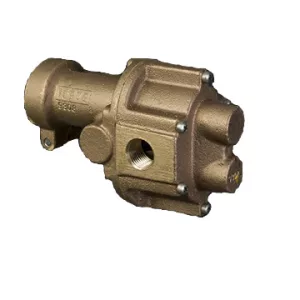
Bronze Gear Pump – N993
Pump housings and gears are made of top quality bronze, shafts are 303 stainless steel. Bearings are designed of high performance carbon graphite material selected for wear resistance and long service life. Gear pumps are positive displacement pumps. Each shaft revolution displaces a definite amount of liquid relatively unaffected by the back pressure in the discharge line. Shaft speed and flow are directly proportional. Recommended pressure limits are 100 PSI for water and non-lubricants, 150 PSI for oil and other lubricants. The maximum shaft speed is 1750 RPM.
Features
- Rugged corrosion resistant bronze construction
- Compact close-coupled design
- Stainless steel shafts
- Durable bronze helical gears provide quiet operation
- Process lubricated carbon graphite bearings
- O-ring cover seal for maximum leak protection
- Nitrile Lip Seal -standard
- Easy field assembly to a variety of motor frames
- For compact AC motor pump units – see Close Coupled Bronze Adapterless Rotary Gear Pumps
- For Danfoss hydraulic motor driven pump units – see adapter 9960
- For bronze pedestal pumps and mechanical seal styles – see model N3000
- For close-coupled ductile iron pumps – see model C993
Performance
- Max Flow: 8.8 GPM – 33.31 LPM
- Max Pressure: 150 PSI – 10 BAR
DRIVE
Close coupled pumps are mounted directly to the electric motor by means of suitable adapter bracket. The pump drive shaft is connected to the motor shaft by a flexible coupling.
LIQUIDS & TEMPERATURES
These pumps are suitable for all liquids that are compatible with bronze. Most common liquids are water, oil, and mild chemicals in the pH range of 4 to 11. Viscous liquids require reduced shaft speeds of 1140 RPM or lower. (Consult factory.) Liquids containing solids, abrasives, powders, or paint pigments are definitely not recommended for gear pumps. If abrasives are unavoidable, use a very low shaft speed. The recommended liquid temperature range is from 32°F to 140°F for best pump life. If more extreme temperature conditions exist, factory should be consulted. Freezing of water-filled pumps can cause damage and must be avoided. Oils at low temperatures are very viscous requiring a lower speed or extra power.
SUCTION LIFT
As a general rule, the suction lift should be kept at an absolute minimum by placing the pump as close to the liquid source as possible. A gear pump in new condition can lift 20 feet of water in the suction line. A foot valve (preferably with built-in strainer) is recommended at the beginning of the suction line. For a first start-up, the pump should be primed to avoid dry running. Minimum size of the suction pipe is the size of the pump inlet port. For longer suction lines (over 3 feet) or for viscous liquids, the pipe should be at least one size or two sizes larger than the pump inlet port.
ROTATION AND RELIEF VALVE
If the discharge line contains any throttling devices such as a shut-off valve, a spray nozzle or other restrictive device, it is necessary to have a relief valve in the system which returns the liquid to the suction side or to the tank. The relief valve is also available as part of the pump itself (R-model pumps). However, built-in relief valves are only good for intermittent service. If used continuously, the pump will overheat. A built-in relief valve is strictly a safety device against overpressure. It will not work successfully as a pressure or flow control device. For this purpose a separate relief valve in the pressure line must be used. Unless otherwise specified, the pump motor unit is supplied by the factory for shaft rotation counterclockwise from pump shaft end. Reversing motor will reverse “in and “out” ports and also requires changing relief valve location. The relief valve is always on the inlet side of this pump series. The factory pressure setting is 50 PSIG. To increase pressure, turn the relief valve adjusting screw in a clockwise direction.
SHAFT SEALS
Close coupled gear pumps are normally supplied with a Nitrile lip seal. A lip seal made of fluoroelastomer is available as an option. For a fluoroelastomer Seal, add S5 to the pump model number.

Bronze Gear Pump – N999
Pump housings and gears are made of top quality bronze, shafts are 303 stainless steel. Bearings are designed of high performance carbongraphite material selected for wear resistance and long service life. Gear pumps are positive displacement pumps. Each shaft revolution displaces a definite amount of liquid relatively unaffected by the back pressure in the discharge line. Shaft speed and flow are directly proportional. Recommended pressure limits are 100 PSI for water and non-lubricants, 150 PSI for oil and other lubricants. The maximum shaft speed is 1750 RPM.
Features
- Rugged corrosion resistant bronze construction
- Compact close-coupled design
- Stainless steel shafts
- Durable bronze spur gears
- Process lubricated carbon graphite bearings
- O-ring cover seal for maximum leak protection
- Nitrile Lip Seal -standard
- Easy field assembly to a variety of motor frames
- For compact AC motor pump units – see Close Coupled Bronze Adapterless Rotary Gear Pumps
- For mechanical seal styles – see carbonator style – model N95060
Performance
- Max Flow: 1.0 GPM – 3.79 LPM
- Max Pressure: 150 PSI – 10 BAR
DRIVE
Close coupled pumps are mounted directly to the electric motor by means of a suitable adapter bracket. The pump drive shaft is connected to the motor shaft by the flexible coupling.
LIQUIDS & TEMPERATURES
These pumps are suitable for all liquids that are compatible with bronze. Most common liquids are water, oil, and mild chemicals in the pH range of 4 to 11. Viscous liquids require reduced shaft speeds of 1150 RPM or lower. (Consult factory.) Liquids containing solids, abrasives, powders, or paint pigments are definitely not recommended for gear pumps. If abrasives are unavoidable, use a very low shaft speed. The recommended liquid temperature range is from 32°F to 140°F for best pump life. If more extreme temperature conditions exist, factory should be consulted. Freezing of water-filled pumps can cause damage and must be avoided. Oils at low temperatures are very viscous requiring a lower speed or extra power.
SUCTION LIFT
As a general rule, the suction lift should be kept at an absolute minimum by placing the pump as close to the liquid source as possible. A gear pump in new condition can lift 20 feet of water in the suction line. A foot valve (preferably with built-in strainer) is recommended at the beginning of the suction line. For a first start-up, the pump should be primed to avoid dry running. Minimum size of the suction pipe is the size of the pump inlet port. For longer suction lines (over 3 feet) or for viscous liquids, the pipe should be at least one size or two sizes larger than the pump inlet port.
SHAFT SEALS
Close coupled gear pumps are normally supplied with a Nitrile lip seal. A lip seal made of fluoroelastomer is available as an option. For a fluoroelastomer Seal, add S5 to the pump model number.
OPTIONAL RELIEF VALVE
If the discharge line contains any throttling devices such as a shut-off valve, a spray nozzle or other restrictive device, it is necessary to have a relief valve in the system which returns the liquid to the suction side or to the tank. The relief valve is also available as part of the pump itself (R-model pumps). However, built-in relief valves are only good for intermittent service. If used continuously, the pump will overheat. A built-in relief valve is strictly a safety device against overpressure. It will not work successfully as a pressure or flow control device. For this purpose a separate relief valve in the pressure line must be used. Unless otherwise specified, the pump motor unit is supplied by the factory for shaft rotation counterclockwise from shaft end. Reversing motor will reverse “in and “out” ports and also requires changing relief valve location. The relief valve is always on the inlet side of this pump series. The factory pressure setting is 50 PSIG. To increase pressure, turn the relief valve adjusting screw in a clockwise direction.

